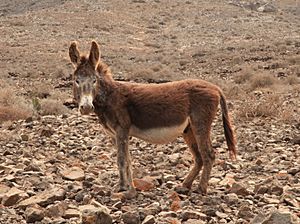Majorera donkey facts for kids

In Pájara, Fuerteventura
|
|
| Conservation status |
|
|---|---|
| Other names |
|
| Country of origin | Spain |
| Distribution |
|
| Traits | |
| Weight |
|
| Height |
|
| Coat | grey in all shades, or brown |
| Classification | |
| Consejería de Agricultura, Ganadería, Pesca y Aguas | Breed standard |
|
|
The Majorera is a special kind of small donkey. It comes from the Canary Islands, which are a group of Spanish islands near the coast of Morocco. These donkeys are quite rare. There are only about 200 of them left. Most of them live on the island of Fuerteventura, and a few are on Lanzarote. The name "Majorera" comes from "majorero," which is what people from Fuerteventura are called. This donkey is the only type of horse-like animal (equine) that originally comes from these islands.
Contents
History of the Majorera Donkey
The Majorera donkey first arrived in the Canary Islands when Spain took control of the islands in the 1400s. Today, you can find them in all six main areas (municipalities) of Fuerteventura. These areas include Antigua, Betancuria, La Oliva, Pájara, Puerto del Rosario, and Tuineje. A small number also live on Lanzarote and other nearby islands.
Why the Majorera Donkey is Endangered
Since 1997, the Spanish Ministry of Agriculture has listed the Majorera donkey as "under special protection" and "in danger of extinction." This means their numbers are very low. In 2007, a group called the FAO said the donkey's situation was "critical." Another group, the SAVE Foundation, called it "endangered" in 2008. Both terms mean the breed is at high risk of disappearing forever.
How Donkeys Were Used in the Past
The Majorera donkey is very good at living in the dry, hot, and volcanic areas of Fuerteventura. Islanders used these donkeys for many important jobs. They rode them, used them to carry heavy loads, and had them pull carts. Donkeys also helped with farm work like ploughing fields.
Decline in Donkey Numbers
Like many other donkey breeds, the Majorera donkey's numbers dropped quickly in the 1900s. This happened because new machines took over many farm jobs. In 2009, there were about 141 Majorera donkeys. By the end of 2013, this number had fallen to just 27. Efforts are now being made to protect and increase their population.
Characteristics of the Majorera Donkey
The Majorera is a small donkey that looks like donkeys from Africa. Most of them are grey, ranging from light to dark shades. Some can also be brown.
Unique Markings
These donkeys often have special markings called "primitive markings." This means they have a darker stripe down their back and another stripe across their shoulders. They might also have faint zebra-like stripes on their legs.
Size and Weight
Majorera donkeys usually stand about 1.00 to 1.20 meters (about 3 to 4 feet) tall at their shoulders. They weigh between 125 and 175 kilograms (about 275 to 385 pounds).
See also
 In Spanish: Burro majorero para niños
In Spanish: Burro majorero para niños

